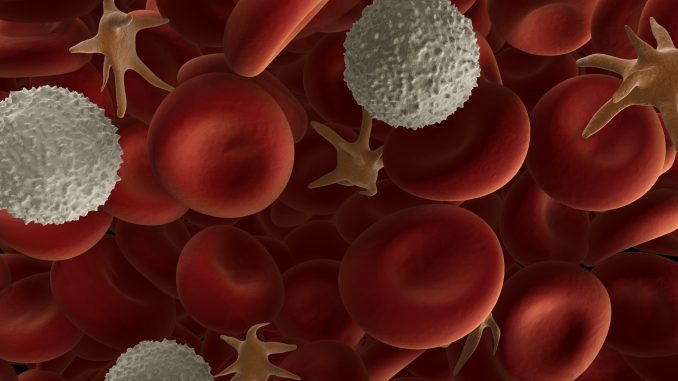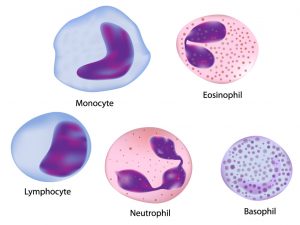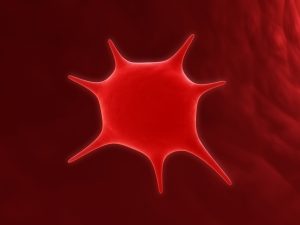
Blood cells
The blood cells constitute about 45% of the total blood volume. There are three major types of blood cells; Erythrocytes, Leukocytes and Thrombocytes. These blood cells are synthesized in the bone marrow inside the bones.
Also see: Differences between blood and lymph
- Erythrocytes (RBCs):
- They are biconcave disk shaped cells and this shape increases the surface area for the gas diffusion on their surface than a flat disk or a sphere.
- A mature RBC lacks a nucleus and hence relies on its store of already produced proteins, enzymes and RNA.
- Measures about 7µm in diameter and are about2µm thick.
- Average life span is of about 90-120 days. They are formed in bone marrow and destroyed in the liver and spleen.
- Average RBC count is 4-6 million/mm3 of blood (average man has 5.5 million/mm3 whereas average woman has about 4.5 million/mm3).
- The principal component of RBC is a red colored pigment or oxygen carrying globular protein called haemoglobin (Hb).
- Haemoglobin consists of 5% haeme or iron and 98% globulin protein.

Functions of RBCs:
- The iron plays a key role in haemoglobin’s function as an oxygen carrying substance by binding and releasing to tissues at the appropriate times in the form of oxyhaemoglobin.
- RBCs also help in the transport of carbon dioxide (about 30%) in the form of carboxyhaemoglobin (HbCO2).
- The amino acids are absorbed by the surfaces of erythrocytes and transport them to the cells from the alimentary canal.
- Leukocytes (WBCs):
- They are of several forms and are capable of independent amoeboid movement since they are of irregular shape.
- They are larger than RBCs but can easily squeeze through the capillaries because of their shape.
- WBCs are nucleated cells and they are fewer in number than the RBCs. The normal leukocyte count is between 4000-11,000/mm3 of blood which may increase as a result of infection to 25,000/mm3.
- Measures about 12-20µm .
- Average life span is of few hours to few days (12 hrs to12 days). WBCs originate from the same undifferentiated cells of blood forming bone marrow, but they are produced in lymphoid tissues such as lymph nodes, spleen and tonsils. Generally, they are destroyed at the site of infection.
The two basic types of leukocytes are: granulocytes and agranulocytes.
a. Granulocytes (polymorphonuclear leukocytes): They contain large number of granules in the cytoplasm outside their multilobed nuclei. The three types of granulocytes are neutrophils, eosinophils and basophils.
i. Neutrophils:
- Larger than erythrocytes and have multilobed nucleus.
- Contain many granules in the cytoplasm
- About 50-75% of total leukocytes are Neutrophils
- Granules appear pink to blue-black in a neutral stain
- Diameter is about 10µm
ii. Eosinophils:
- They have a ‘B” shaped nucleus
- Constitute about 1% of the total leukocytes
- Granules appear red to red-orange in an acidic stain
- Diameter is about 10µm
iii. Basophils:
- They have an elongated and indistinctly lobed nucleus
- Constitute less than 1% of the total leukocytes
- Granules contain histamine and heparin and appear blue-black to red-purple in basic stain
- Diameter is about 10µm
b. Agranulocytes (mononuclear leukocytes) : They do not contain any granules but despite their name, they usually have a few nonspecific lysosome granules in their cytoplasm. The two types of agranulocytes are monocytes and lymphocytes.
i. Monocytes:
- They are the largest blood cells, approximately two to three times larger than RBCs.
- They have large folded nucleus
- Diameter is about 20µm
- Constitute about 2-8% of the total leukocytes
ii. Lymphocytes:
- They are small, mononuclear, agranular leukocytes
- Large round nucleus nearly fills the cell
- Diameter is about 10µm
- Constitute about 20-40% of the total leukocytes
- They are found abundant in the lymphoid tissue

Functions of WBCs:
- Neutrophils destroy microorganisms and other foreign particles by phagocytosis (engulfing invading germs of diseases).
- Eosinophils modulate allergic and inflammatory reactions and also destroy the antigen-antibody complexes.
- Basophils are also involved in allergic reactions and inflammation.
- Monocytes under stress conditions, become macrophages ( large mobile phagocytes) and destroy harmful particles.
- Lymphocytes are involved in the immune response and synthesis of antibodies.
Hence, overall function of WBCs is they serve as scavengers that destroy microorganisms at infection sites, help remove foreign molecules and remove debris that results from dead or injured tissue cells.
- Thrombocytes (platelets):
- They are disk shaped and are about one-quarter the size of RBC.
- They are the fragments of megakaryocytes and look like pinched off parts of larger cells.
- They too are non-nucleated like RBC.
- Diameter ranges from 2-4µm (the smallest blood cells).
- They are much more numerous than leukocytes averaging about 350,000/mm3 of blood.
- Once in blood, their average life span is about 7-8 days.
- Like other blood cells, they are synthesized in the bone marrow.
- After entering the blood stream, platelets begin to pick up and store chemical substances that can be released later to help seal vessel breaks.

Functions of platelets:
- Platelets adhere to each other and help in blood coagulation (blood clotting) in injury thus preventing excessive bleeding and blood loss.
- Platelets also release serotonin which constricts broken or injured vessels and retards bleeding.